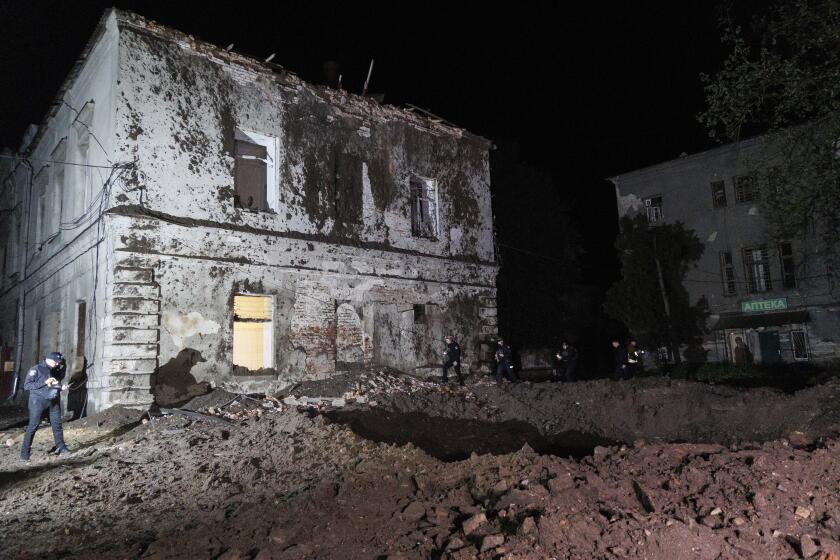VICTORY IN EUROPE
Fifty years ago, Germany’s unconditional surrender brought to an end six years of fighting in Europe that claimed nearly 46 million lives--more killed than in all other conflicts in the world combined in the ensuing half-century. The end of World War II in Europe--V-E Day--came after a two-week campaign leading to the fall of Berlin.
German Denouement
On April 16, the final, 17-day battle for the German capital began. Germany capitulated May 8.
APRIL 16
* Soviet armies under commanders Georgi Zhukov and Ivan Koniev begin attack; preliminary artillery barrage uses one gun every 13 feet along a 55-mile front.
* (1) Zhukov, attacking from Kustrin bridgehead, meets fierce resistance at first of three German defense lines.
* Koniev crosses Neisse River, breaks into open country.
APRIL 17 (2)
* Zhukov breeches first line of German resistance and immediately meets second; attack slows.
APRIL 19
* Soviets reach outskirts of Berlin, trap German 9th Army, much of 4th Panzer Division.
APRIL 20
* At last meeting, Nazi leaders celebrate Hitler’s 56th birthday in his bunker beneath city.
* Americans/British make last air raid on city; gas, electricity, sanitation services cease.
* Koniev captures Zossen, just 20 miles south of Berlin. Begins approach on southern suburbs of capital.
APRIL 21 (4)
* Zhukov breaks through autobahn ring north of city.
* Koniev enters southern suburbs of Berlin.
APRIL 22
* Hitler announces he will stay in city to direct defense.
APRIL 23
* Too late, Hitler sees city will be surrounded; he futilely orders armies fighting in west against Americans and British to return.
APRIL 24
* Soviets finish encircling Berlin, meet southwest of city.
APRIL 25 (5)
* Americans meet Soviets near Torgau, on Elbe; German armies in west fail to reach Berlin.
APRIL 26
* Soviets begin final assault.
APRIL 27
* German resistance in streets reduced to narrow corridor.
APRIL 28
* Gen. Karl Weidling, commanding Berlin garrison, tells Hitler only two days of ammunition remain, food is not available.
APRIL 29
* Hitler marries Eva Braun, drafts last will and political testament.
* Weidling reports worsen: no ammunition left, no chance of help from outside.
APRIL 30
* At 1:30 p.m., after artillery and rocket attack, battle for Reichstag, German parliament building, begins.
* Hitler, Braun retire to his suite; at 3:30 p.m. she takes cyanide, he shoots himself. Bodies are cremated.
* First attack on Reichstag is repulsed; second succeeds. By 6 p.m. Soviets are inside.
* Two Soviets raise victory flag over building; fighting continues from room to room.
MAY 1
* Reichstag falls; 2,500 Germans killed, 2,600 surrender
* Propaganda chief Joseph Goebbels commits suicide.
MAY 2
* Weidling decides to surrender. By 3 p.m., battle ends.
The Spoils
In 1943, President Franklin D. Roosevelt proposed a postwar division of Germany very different from what came to pass, with the U. S. controlling the northwest sector stretching to Berlin. But this plan was shelved by his own advisers until an alternative British plan became a fait accompli .
Understatement
Allied Supreme Commander Gen. Dwight Eisenhower used this simple message to inform his U.S. and British chiefs Germany had surrendered:
“The mission of the Allied force was fulfilled at 0241, local time, May 7, 1945.
Gen. Eisenhower.”
Human Toll
The U.S. death toll for WWII was 406,000. European nations also suffered huge losses. Military an civilians killed and missing: Belgium: 100,000 Britain: 490,000 Czechoslovakia: 317,000 Denmark: 7,000 Finland: 90,000 France: 418,000 Germany/Austria: 5,500,000 Greece: 418,000 Hungary: 427,000 Italy: 560,000 Netherlands: 256,000 Norway: 13,000 Poland: 6,600,000 Romania: 538,000 U.S.S.R.: 27,700,000 Yugoslavia: 1,705,000 Sources: The Illustrated History of the World Wars; The United States and World War II, Vol. II; Reader’s Digest Illustrated History of World War II
Researched by TOM REINKEN / Los Angeles Times
More to Read
Start your day right
Sign up for Essential California for news, features and recommendations from the L.A. Times and beyond in your inbox six days a week.
You may occasionally receive promotional content from the Los Angeles Times.






